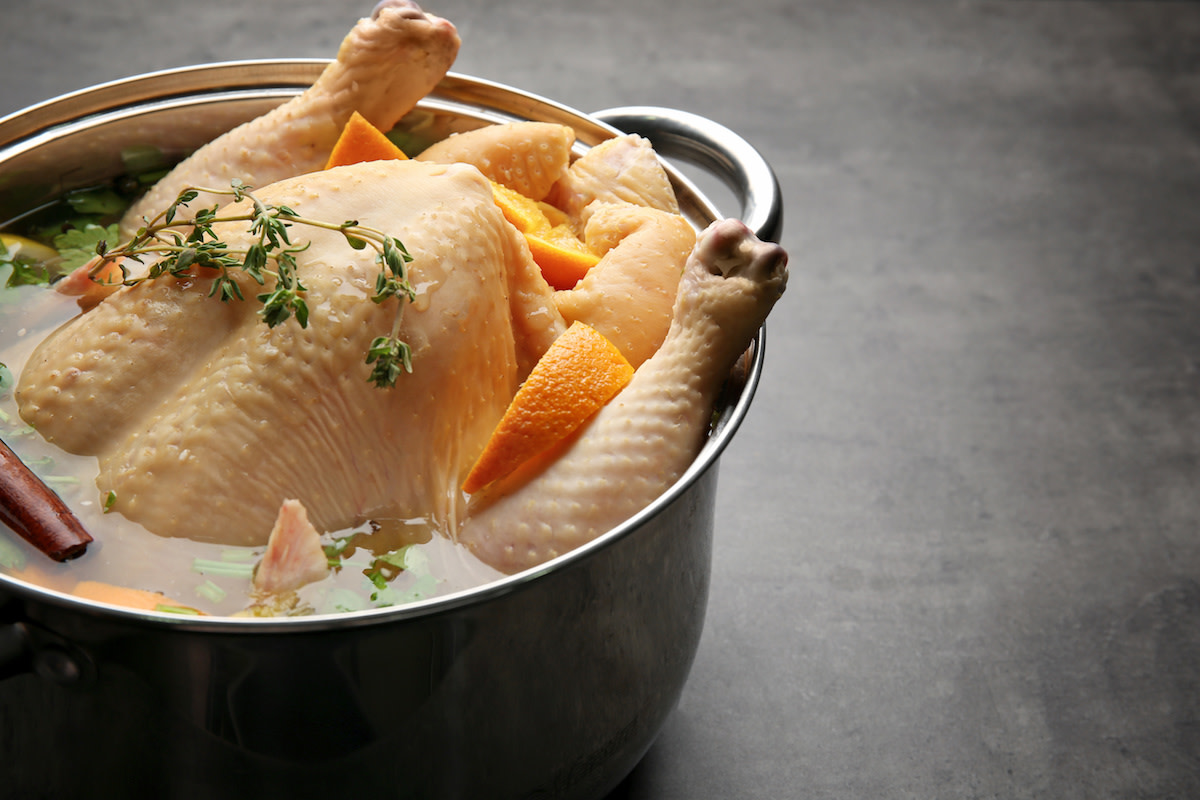What Is Brine? Learn How to Brine Fish, Meat, and Poultry, Plus 3 Brining Recipes
Written by MasterClass
Last updated: Aug 11, 2021 • 3 min read
Come Thanksgiving turkey time, you can expect a raging to-brine-or-not-to-brine debate to light up both the Internet and the aisles of the grocery store. Whether you wet brine, dry brine, or no-brine your bird, here’s why some people swear by the technique—any time of year, for any cut of meat.
Learn From the Best
What Is Brining?
Brining is a technique that involves submerging meat in a salt solution prior to roasting or grilling. The brining process adds an extra hit of flavorful moisture—always a plus when dry, tough meat is a risk—and the salt water goes to work on the muscle fibers and proteins in the meat itself, separating them and creating more space to trap water. Osmosis!
Use this basic brine ratio: ¼ cup kosher salt to 4 cups water (or, for larger projects, 1 cup salt to every gallon of water). You can also add in whichever spices and aromatics you’ve got kicking around—think whole peppercorns, bay leaves—though the flavors will likely come through stronger with a dry brine approach, since the spices are applied directly to the surface of the meat and not diluted in water.
What Foods Should Be Brined?
Lean cuts that have a tendency to dry out or become tough are prime candidates for brining (no offense, turkey), but it can also make a difference with chicken breasts, pork chops, fish (like halibut), or steak.
What's the Difference Between Dry Brining and Wet Brining?
The key difference between a dry brine and a wet brine comes down the way the salt functions: in a wet brine, the salt is responsible for helping the meat hang on to all that extra moisture. In a dry brine, the salt first draws moisture out of the meat, and is re-absorbed with the juices in a concentrated natural brine, if you will. In both cases, salt affects the behavior of the muscle fibers.
How Is Brining Different From Pickling, Curing, and Marinating?
- Marinating: The easiest way to distinguish a brine solution from a marinade is that while a brine is all about moisture, a marinade is primarily concerned with flavor. Marinades also feature things like acid to help break down muscle fibers.
- Pickling: While pickling does feature a salt solution, its defining features is lactic and acetic acids from a brine made with vinegar.
- Curing: Like brining, salt is the hero of curing, which preserves something instead of making it more tender. Like a dry brine, packing meat in salt for a specific period of time draws out the moisture and concentrates the flavor.
Basic Brining Times
While a larger piece of meat like a whole turkey might take a full day to properly brine, with smaller individual cuts you can usually get away with 1 hour prior to cooking. (A good rule of thumb is 1 hour for every pound.)
4 Tips for Brining Meat
- 1. The Vessel: Choose a container (ideally one made of a non-reactive material: glass, stainless steel, or a brining bag) that’s big enough to allow the brining solution to completely cover the meat. If you find you need to stop it from floating, simply weigh it down with a small plate or bowl.
- 2. The Salt Concentration: Water should always be the dominant ingredient in a brine. You can use both kosher salt or table salt, but you may want to vary the ratios. Kosher salt crystals are slightly larger, which means the same amount of table salt will give you a stronger salt solution per volume.
- 3. Before you cook: Post-brine, be sure to rinse and pat meat dry before grilling or roasting.
- 4. Temperature: If you’re incorporating spices in a boiled brine, let it cool completely to room temperature before adding it to the meat.
3 Basic Brine Recipes
- 1. Combine ½ cup kosher salt, ½ cup light brown sugar, ¼ cup whole black peppercorns, and 1 bay leaf in a large pot with 1 quart of water. Bring to a boil (or simply whisk if you’re cold brining) and allow the salt and sugar to dissolve, then remove from heat and let cool completely.
- 2. Combine 1 cup soy sauce, ¾ cups kosher salt, 1 gallon water, 2 tablespoons minced garlic, ¼ cup brown sugar. Whisk to dissolve solids, then use with chicken or pork chops.
- 3. If you’re in need of a lightning quick brine that’ll get the job done with no bells and whistles, simply add 1 tablespoon of salt and 1 cup cold water to a container until there's enough to cover whatever you need to brine. Throw it in the fridge, wait an hour or so. That’s it!
Become a better home cook with the MasterClass Annual Membership. Gain access to exclusive video lessons taught by culinary masters, including Chef Thomas Keller, Gordon Ramsay, Wolfgang Puck, and more.
